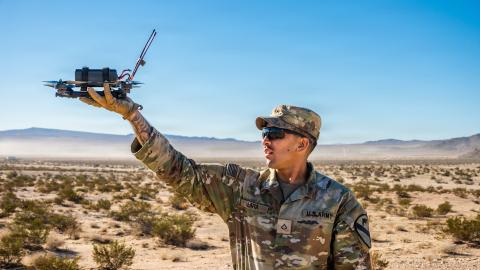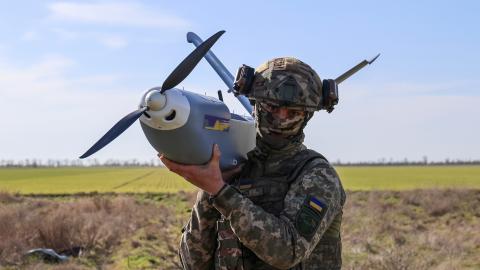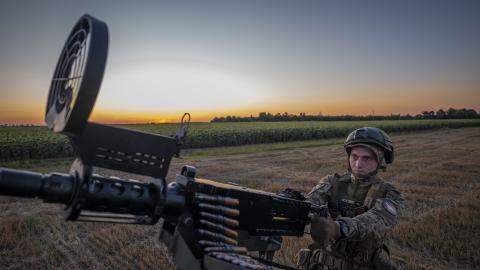Executive Summary
- Ukraine’s deep-strike campaign: Ukraine struck the Volgograd refinery, which produces almost 5 percent of Russia’s oil output. The strike forced the facility to halt operations.
- Battlefield assessment:The Ukrainian military rushed detachments from elite combat formations to the critical Pokrovsk sector to shore up its weakened lines of defense.
- Russia’s air war: Russian Shahed drone attacks hit a record high in July. It fired an average of 103 drones at Ukraine per day.
1. Battlefield Assessment
Last week the operational tempo of the conflict spiked. The Ukrainian General Staff noted that its forces had participated in as many as 130 combat engagements on some days, with more than 30 percent of such efforts taking place in the Pokrovsk sector.
Despite the headlines generated by the Russia–United States summit in Alaska, Russian units did not slow their efforts to capture the city. To repel Russia’s push into the critical stronghold, the Ukrainian military has reallocated detachments from combat formations in other sectors. Most recently, Ukrainian command has moved troops from the 25th Airborne Brigade, the 79th, 82nd, and 92nd Air Assault Brigades, the Security Service of Ukraine (SBU), the Azov Brigade, and the 38th Marine Brigade into the sector. The 79th Air Assault Brigade has already managed to recapture territory and seize Zolotyi Kolodyaz, a small town 30 miles from Pokrovsk.
This success is a ray of hope for Ukraine and its supporters. But Ukraine’s manpower shortage means its forces still face major disadvantages in force-on-force and force-to-terrain ratios. The newly deployed Ukrainian units are likely to serve only as a temporary salve. Kyiv will continue to struggle to defend the Pokrovsk sector, especially as Russia has breached sections of the front near Dobropillya, a small city north of Pokrovsk.
No drastic territorial changes occurred elsewhere. Intense fighting continued, as it has in recent weeks, near Lyman, Kupiansk, Toretsk, and Orikhiv.
Away from the front lines, Ukraine’s Main Directorate of Intelligence (GUR) released the technical specifications of a new delta-wing drone that Russian units have been using in combat. The unmanned aerial vehicle (UAV), probably a variant of Russia’s Italmas drone, shares a design philosophy with the Shahed, though with a shorter range. Over half of the components in the new drone originated in China, including communications modules, memory chips, and other critical parts. In recent months Ukrainian analysts have found an increasing number of Chinese-made components in Russian weapons systems, a trend this report will monitor.
On the offensive side, Kyiv continued to hit critical petrochemical facilities deep inside Russia. Last week it struck the Volgograd refinery, a facility responsible for 15 million tons of annual oil production, or roughly 5 percent of Russia’s overall output. Ukraine’s strikes forced the refinery to halt its processing operations.
2. Russian Drone Attacks Reach a Record Monthly High
Russian drone attacks continue to menace Ukraine’s cities and pose a significant threat to both Ukraine and, potentially, the North Atlantic Treaty Organization (NATO).
Russia launched more drones at Ukraine in July 2025 than it has in any other month of the conflict, firing at least one Shahed salvo each day. In total, the Kremlin’s forces launched around 6,200 UAVs, or a daily average of 103. This marks an increase of almost 20 percent from June. Most of these munitions were Russian-Iranian Shahed variants aimed at Ukrainian civilians. The Ukrainian military intercepted 88 percent of Russia’s attacks, using both kinetic means and electronic warfare measures.
There are two main reasons Russia has increased its long-range attacks. First, as this report has covered thoroughly, Moscow has been expanding the Russian-Iranian drone plant in Tatarstan and establishing new production facilities. The Kremlin has also initiated programs such as Alabuga Start to recruit impoverished young workers from Africa and other parts of the developing world.
Second, imagery intelligence indicates that Russia is using new launch positions and increasing the number of facilities it uses to store munitions. Given these trends, Russia could achieve 10,000 monthly Shahed launches before the end of the year.














